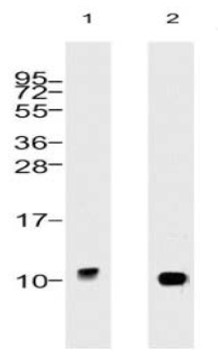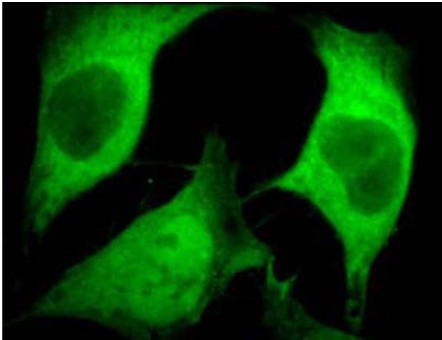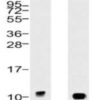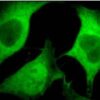Anti-Ubiquitin Antibody (11023)
$357.00
| Host | Quantity | Applications | Species Reactivity | Data Sheet | |
|---|---|---|---|---|---|
| Mouse | 100ug | WB,ELISA | Human, Mouse, Rat, Bovine |  |
SKU: 11023
Categories: Antibody Products, Apoptosis Antibodies, Products
Overview
Product Name Anti-Ubiquitin Antibody (11023)
Description Anti-Ubiquitin Mouse Monoclonal Antibody
Target Ubiquitin
Species Reactivity Human, Mouse, Rat, Bovine
Applications WB,ELISA
Host Mouse
Clonality Monoclonal
Clone ID 5B9.B3
Isotype IgG2a
Immunogen Native bovine ubiquitin conjugated to KLH
Properties
Form Liquid
Concentration Lot Specific
Formulation PBS, pH 7.4.
Buffer Formulation Phosphate Buffered Saline
Buffer pH pH 7.4
Format Purified
Purification Purified by Protein G affinity chromatography
Specificity Information
Specificity This antibody recognizes human, mouse, rat, and bovine ubiquitin. Other species have not been investigated.
Target Name Polyubiquitin-B [Cleaved into: Ubiquitin]
Target ID Ubiquitin
Uniprot ID P0CG53
Gene Name UBB
Gene ID 281370
Accession Number NP_776558.1
Sequence Location [Ubiquitin]: Cytoplasm, Nucleus, Mitochondrion outer membrane, Peripheral membrane protein
Biological Function [Ubiquitin]: Exists either covalently attached to another protein, or free (unanchored) (By similarity). When covalently bound, it is conjugated to target proteins via an isopeptide bond either as a monomer (monoubiquitin), a polymer linked via different Lys residues of the ubiquitin (polyubiquitin chains) or a linear polymer linked via the initiator Met of the ubiquitin (linear polyubiquitin chains) (PubMed:26116755). Polyubiquitin chains, when attached to a target protein, have different functions depending on the Lys residue of the ubiquitin that is linked: Lys-6-linked may be involved in DNA repair; Lys-11-linked is involved in ERAD (endoplasmic reticulum-associated degradation) and in cell-cycle regulation; Lys-29-linked is involved in proteotoxic stress response and cell cycle; Lys-33-linked is involved in kinase modification; Lys-48-linked is involved in protein degradation via the proteasome; Lys-63-linked is involved in endocytosis, DNA-damage responses as well as in signaling processes leading to activation of the transcription factor NF-kappa-B (By similarity). Linear polymer chains formed via attachment by the initiator Met lead to cell signaling (By similarity). Ubiquitin is usually conjugated to Lys residues of target proteins, however, in rare cases, conjugation to Cys or Ser residues has been observed (By similarity). When polyubiquitin is free (unanchored-polyubiquitin), it also has distinct roles, such as in activation of protein kinases, and in signaling (By similarity). {UniProtKB:P0CG47, PubMed:26116755}.
Research Areas Apoptosis
Background Ubiquitin, a small protein comprised of 76 amino acids with a molecular mass of approximately 10kDa, is highly conserved among eukaryotic species. The primary role of ubiquitin is to clear abnormal, foreign, and improperly folded proteins by targeting them for degradation by the 26S proteosome. Ubiquitination of proteins is an essential process that is regulated by ubiquitin- activating enzymes, ubiquitin-conjugating enzymes, and ubiquitin-protein ligases. Ubiquitination also occurs in the internalization and degradation of plasma membrane proteins.
Application Images



Description Immunoblotting: use at 1ug/ml. A band of ~10kDa is detected. (1) HeLa whole cell lysate, (2) Jurkat whole cell lysate.

Description Immunofluorescence: use at 10ug/ml. 2% formaldehyde-fixed HeLa cells, 100X magnification.
Handling
Storage This antibody is stable for at least one (1) year at -20°C.
Dilution Instructions Dilute in PBS or medium that is identical to that used in the assay system.
Application Instructions Immunoblotting: use at 1ug/mL.
Immunofluorescence: use at 10ug/mL. A band of ~10kDa is detected
ELISA: use at 1ug/mL with ubiquitin on the solid phase.
These are recommended concentrations.
Enduser should determine optimal concentrations for their applications.
Immunofluorescence: use at 10ug/mL. A band of ~10kDa is detected
ELISA: use at 1ug/mL with ubiquitin on the solid phase.
These are recommended concentrations.
Enduser should determine optimal concentrations for their applications.
References & Data Sheet
Data Sheet  Download PDF Data Sheet
Download PDF Data Sheet
 Download PDF Data Sheet
Download PDF Data Sheet




